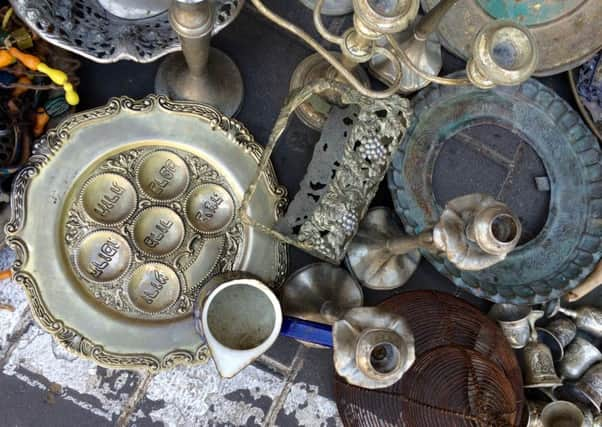TRAVEL REVIEW: Israel - much more than you might think


Smart restaurants spill into the streets and the din of noisy celebrations resonate along the busy thoroughfares of this sea-facing city.
It doesn’t feel at all like the Middle East. It certainly doesn’t feel like the Israel I’d come to expect from chaotic news reports.
Advertisement
Hide AdAdvertisement
Hide AdIt is Tel Aviv and as first impressions go, it couldn’t get much better.


It’s a couple of days before Passover and there is a party atmosphere in Israel’s second city. The beach is full and the city streets are filled with people coming to and from to the chorus of flip-flops.
It is so laid back and the restaurants of Rothschild Boulevard, famed for its Bauhaus architecture, are filled with young, trendy-types sipping cocktails and sharing plates of colourful mezze.
We arrive at Social Club, one of the city’s hottest restaurants. It’s hectic.
Advertisement
Hide AdAdvertisement
Hide AdOur guide points out a couple of celebrities. President Ariel Sharon’s former public relations man and a well-known comedian trade barbs at the bar and at the table behind us a former contestant on Israel’s version of Big Brother scoffs lamb cutlets with a group of friends.


The food is outstanding. We gorge on platter of warm chewy flat breads, crisp fried falafel, parsley salad, pickled beetroot, velvety hummus, smoky baba ganoush and nutty tahini sauce.
For dessert a first taste of halva, a sweet made from ground sesame paste that is everywhere across Israel. Utterly decadent and I’m left bursting at the seams.
I go on to spend five days in Israel and every meal is just as good. Perhaps it’s the mix of Middle Eastern, African and European cultures that makes for such exciting food. The whole place is more cosmopolitan, more multicultural than I could have imagined. An instant antidote to so many preconceptions about Israel.
Advertisement
Hide AdAdvertisement
Hide AdIn the morning we explore more, heading off to Jaffa, Tel Aviv’s old city. It looks more typically Middle Eastern. Ottoman-era alleyways perch above an old fishing port and at its heart there is a ramshackle flea market with a warren of eclectic stalls.


Fake Man United kits hang alongside menorahs. Jewish shops rub up against Arab ones and the air is filled with scent of car exhausts, frankincense and falafel. Utterly intoxicating.
The old city is a hub for artists with many galleries hidden in its labyrinthine streets. We discover the Ilana Goor Museum. Set in a 270-year-old inn, this unusual museum, which is artist Ilana Goor’s own home, includes an extensive variety of works from her as well as an collection of work by other well-known artists.
We take our time exploring its treasures. Vered Aharonvitch’s totally bonkers fountain depicting Neptune being harangued by a group of water-pistol toting kids, is worth the admission alone.
Advertisement
Hide AdAdvertisement
Hide AdIf it’s more history you want, head to Jerusalem, where the over-used term ‘living history’ really does apply.


Israel’s capital is the heart of the Holy Land; where the Jews raised the First Temple to keep the Ark of the Covenant safe, where Jesus was crucified and rose again, and where the Prophet Muhammad ascended to heaven to receive God’s word.
The number of sights here can be so overwhelming that dozens of foreign visitors a year are said to suffer delusions that they are figures from the Bible. It’s become known as Jerusalem Syndrome and Israel’s health ministry records around 50 cases a year where the delusions are so strong that police or mental health professionals are forced to intervene.
I resist any strange feelings when I join hundreds of pilgrims to walk the Via Dolorosa, held to be the path that Jesus walked on the way to his crucifixion.
Advertisement
Hide AdAdvertisement
Hide AdThe route cuts through a busy souk, bigger than any market I’ve ever seen, on route to the Church of the Holy Sepulchre, which is said to stand on the site of his crucifixion and resurrection. It is frenetic inside with Christians of all denominations making the pilgrimage.
Walking these streets is like walking through history itself. I can’t help be moved, even as a committed atheist.
There is plenty to do outside the city too. The impressive Israel Museum is home to the Dead Sea Scrolls and the Yad Vashem Holocaust Memorial Museum is a poignant and deeply sobering complex of museums spread over 45 acres to remember the millions killed at the hands of the Nazis. Be prepared to be particularly moved by the children’s memorial made from reflected candlelight, representing the one and a half millions Jewish children killed in the atrocities. It is something that will stay with you.
For a unique day trip out of the city, head into the Judean Desert to the lowest point on earth, where you can float in the Dead Sea. The unusually high salt concentration – 8.6 times saltier than the ocean – means it is virtually impossible to sink.
Advertisement
Hide AdAdvertisement
Hide AdIt gets its name from the fact that no creatures can live in its saline waters. But these days tourists flock to its shores to cake themselves in the gloopy mud from its banks and take selfies as they float hippopotamus-like in the slimy water. It is pretty gross, to be honest, but a one-of-a-kind experience nevertheless.
While there, don’t miss the magnificent Massada fortress built high up on desert mountain by King Herod in the year 30BC. The place – Israel’s first UNESCO world heritage site – has a thrilling history and boasts some breathtaking views.
There is so much more to see, but too little time. What’s clear, after my brief exploration, however, is that there is far more to Israel than I ever realised.
It is pretty easy to have a one-sided view of Israel but if you want guaranteed weather, ultra cool cities, loads of history and one-of-a-kind experiences, it is hard to beat.